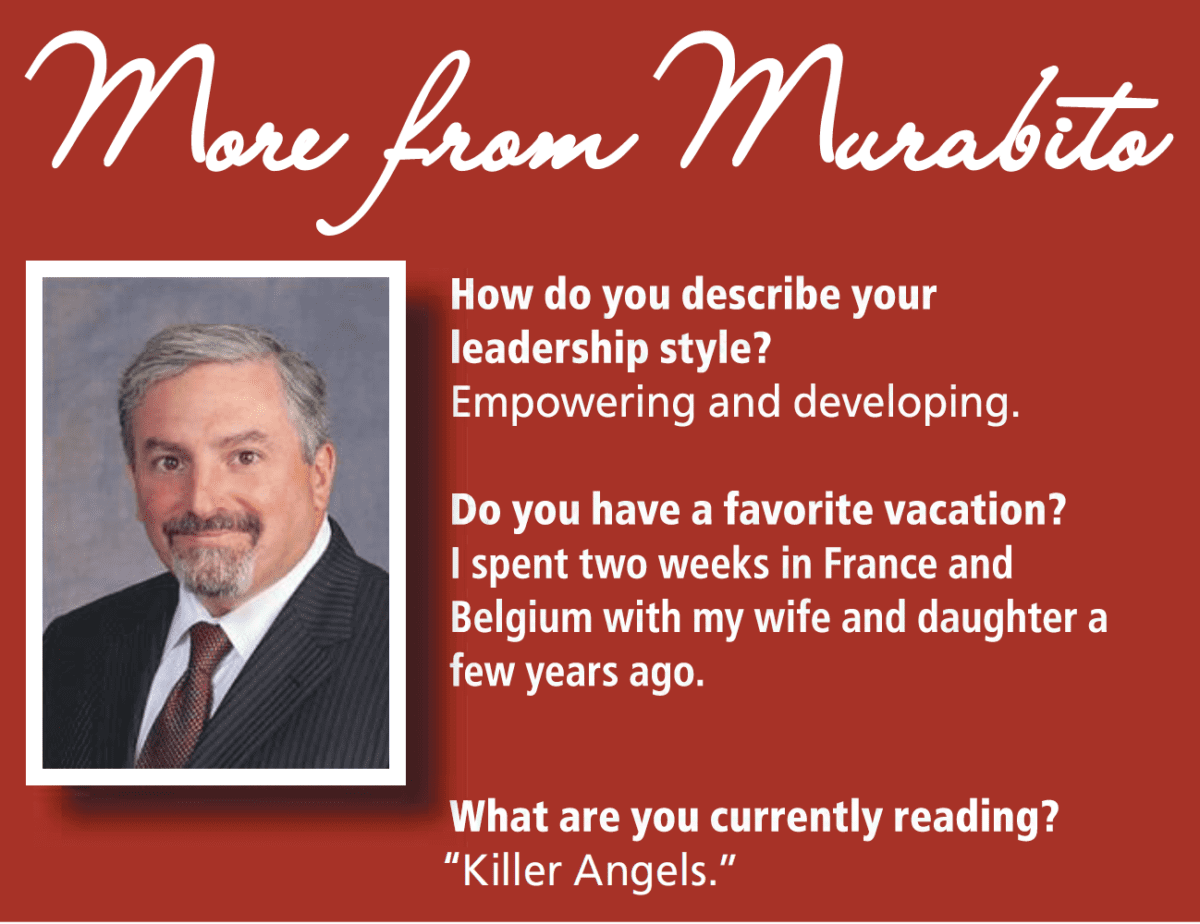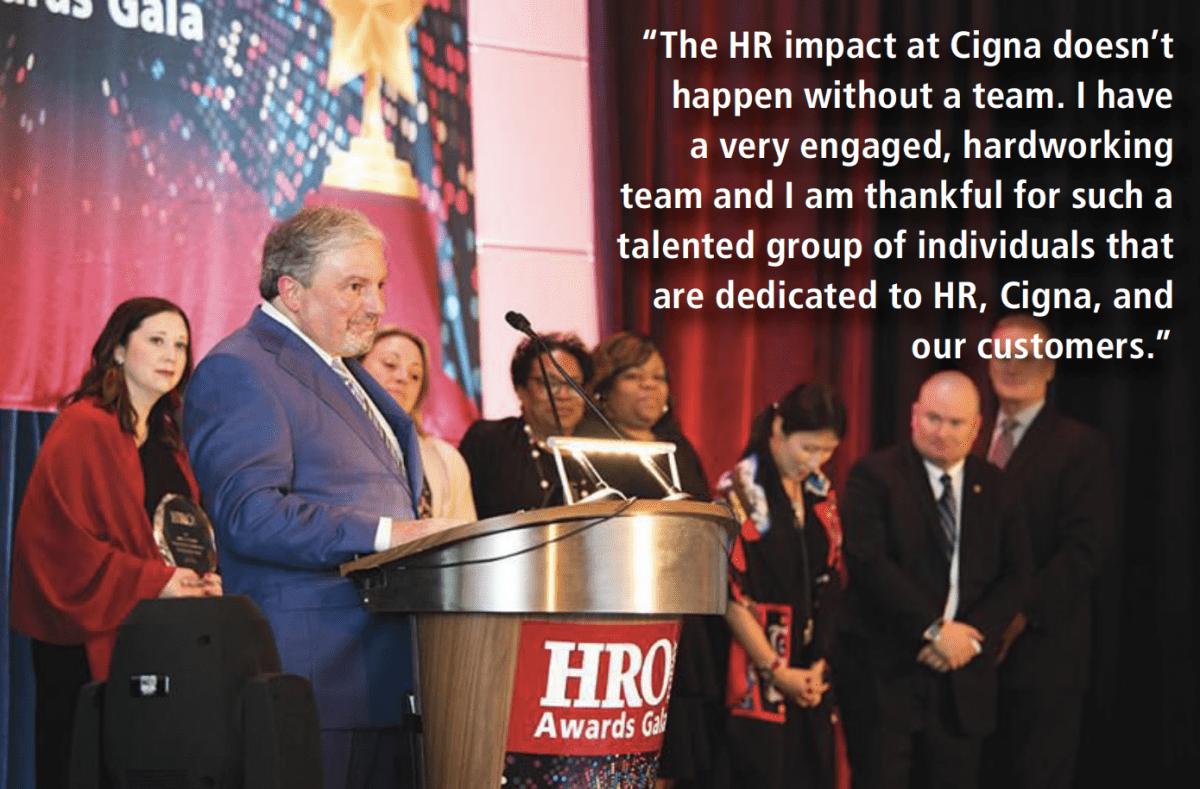Cigna’s CHRO John Murabito leverages a data-rich people strategy to drive proactive business decisions.
By Debbie Bolla
“What we do in HR starts with the needs of the business.”
That’s Executive Vice President and CHRO John Murabito’s guiding philosophy for the human capital management approach at Cigna, a global health services organization that recently acquired Express Scripts. This major acquisition added more than 50 percent headcount to the already 45,000-plus global workforce. So it’s not surprising that one of the business’ top priorities is navigating the change that comes with more than doubling its workforce.
The 2019 CHRO of the Year Award winner explains that transparent communication has been key in this process, along with focusing on company values and an aligned culture. “More than anything, as we are bringing the two companies together, the operating model, the structure of our organization, and the selection of key people are strong areas of focus in order to get to the best outcomes,” Murabito says.
He also shares two enablers of Cigna’s talent strategy: data and unique employee benefits. Learn more in this exclusive interview.
What are some challenges that came with the acquisition of Express Scripts and how is HR navigating them?
The fear of the unknown has always been one of the big human capital challenges when it comes to an acquisition. That is a main reason we elevated change management and communications to the steering committee level and began to focus on it at the pre-close stage. We wanted to be in control of our messages to the organization so that employees didn’t let uncertainty or absence of information get in the way of productivity. We wanted to be as transparent as possible given the level of uncertainty that exists during mergers and acquisitions.
The cultural change is also a factor. Cigna is a longstanding, proud company with a very distinct culture that people love and Express Scripts is a newer, more entrepreneurial company that has grown quickly with its own culture that people are proud of. So we worked with a small team, including an employee advisory board, to understand the culture tenets of each organization. During this process, we looked for overlap and also areas were the culture was different.

- strategy;
- structure;
- people;
- process; and
- rewards.
We kept those five things in mind to ensure that as we try to construct the new company, we are using those five tools to reinforce the type of culture that we want.
We have been deliberate and informed in our thinking when it comes to how we approach policies, making sure it wouldn’t only be the “Cigna way.” We undertook a thorough review of each of the legacy company’s policies and benchmarked industry standards as well. From there, we put together a best-in-class set of policies, practices, and programs to best support our employees. Our culture needs to support the whole of the new company -not just the old company. So right up front, we also established the values of the new organization. The values are the foundation of what we’d like the new culture to stand for.
Our values are:
- We care deeply about our customers, patients, and coworkers.
- We partner, collaborate, and keep our promises.
- We innovate and adapt.
- We act with speed and purpose.
- We create a better future -together.
We have also done a lot of measuring and surveying employees throughout the integration process, asking employees their opinions on the merger:
- Are they excited about it?
- Do they understand the combination?
- Is it too much change?
- Can they manage the change?
- What’s the level of uncertainty?
- Do they intend to stay?
With the survey responses, we do considerable analysis to help us understand where we have issues and where we don’t. And we address the areas where we have issues through communication and education.
How does technology help support Cigna’s approach to talent acquisition and management?
The combined company has a rich, strong history of growing talent through talent development and succession practices. These approaches are going to be more necessary in the future than they ever have been in the past. As we continue to grow, technology will facilitate the movement of talent across the organization and provide employees with opportunities to develop, learn about different roles, and support their career progression. Technology gives us a strong end-to-end talent solution that starts with the recruiting process and proceeds through the entire lifecycle of an employee.
How are you leveraging HR analytics to gain insight into your talent? How does the data you have help advise and guide the business?
Analytics really help guide the work we do in HR and there’s no question that analytics are a key enabler of our overall talent strategy. We have an HR analytics team that is really passionate about data. And what we learn from the data helps us prioritize our actions and better understand what drives our outcomes.

There are a lot of different elements that go into “knowledge of when people leave.” We’ve been able to capture that data and link it to engagement survey data to predict the employees who are at the highest risk for turnover. This is based on common elements that we’ve witnessed with others. Some of these elements include:
- current compensation;
- position in their careers;
- time since their last promotion; and
- tenure in other positions or jobs.
This provides the opportunity to share with leadership the fact that they have an employee on their team that fits the risk profile and could be a potential retention risk. It has spurred a lot of actions that may have otherwise not happened.
Recently, HR leveraged an organizational network analysis, which is an analytic tool that helps identify key influencers across the organization who drive change initiatives. It provides a blueprint of informal networks of colleagues in the company and details when colleagues rely on each other and what they rely on each other for. It helps identify hidden gems within the organization who are really the connectors in the company and who don’t always get the attention others might.
How does HR support the business and what the business asks of them day-to-day to move forward?
I’ve always told my team: What we do in HR starts with the needs of the business. In HR, there are always new trendy programs to recommend to the C-suite, but if they are not in support of your business strategy and the delivery of solutions to business challenges, they are not worth doing. We stay focused on the business, including our Centers of Excellence (COEs) that provide expert programs on learning, leadership development, compensation, benefits, and diversity, and our HR business partners who are around the world and in the field staying abreast of what the business needs. More than anything, as we are bringing the two companies together, the operating model, the structure of our organization, and the selection of key people are strong areas of focus in order to get to the best outcomes. The growth of talent was, is, and will be important going forward. In a growing, service-based business like Cigna, we are going to win based on our passion and intellect.
Why does Cigna invest in outside-of-the-box employee benefits programs and what has been their impact on attracting and retaining talent?
We’ve tried to have some things that are unique in our benefits programs that support our employees and their communities. These programs absolutely benefit the business because they allow us to put forth an employee value proposition, both for new joiners as well as current employees. They allow us to attract and retain the most engaged employees. The “Global Stock Award” was an opportunity to reward the entire workforce while showing employees how valuable they are to the company and that we are all owners in what we are trying to accomplish.
The “Caregiver Leave Program” gives employees peace of mind that they will be able to care for an older parent, a new baby, a military veteran, or an unexpected illness. This time off lessens anxiety and stress. Those are direct advantages to the business in terms of keeping people focused on their work rather than worrying.
The “Community Ambassador Fellowship” provides up to a three-month leave for community work in areas that align with our civic affairs and community focus. We’ve had 20 employees take advantage of the program since its inception a few years ago. We are about to select another 12 from about 100 applications. We’ve had employees do incredible things around the world -working on prosthetic hands in Indonesia and Africa, helping in UN refugee camps, funding grants for medical equipment. The workforce of today is particularly conscious of environmental and social issues. Whether employees apply for it or not, they understand that this Cigna program is making a difference. It drives engagement, it’s inspirational, and employees are excited about it.
LEARN MORE
[metaslider id=16469]














